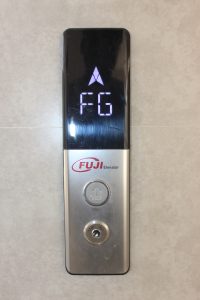The Fuji Lift LOP (Lobby Operating Panel) is a control panel typically located in the lobby or main entrance area of a building where the lift (elevator) is situated. This panel is used by passengers to call the lift to a particular floor. It’s an important part of the lift system’s interface, and like most lobby operating panels, it’s designed to be user-frie ndly, safe, and efficient.
ndly, safe, and efficient.
Here’s a detailed description of the Fuji Lift LOP:
Key Features & Functions:
- Floor Selection:
- The LOP typically includes buttons or touch panels for selecting the floor that the passenger wants to go to. These are usually labeled with floor numbers or sometimes with floor names for clarity.
- Call Buttons:
- The Up and Down buttons allow passengers to call the lift to their current floor. The button lights up to indicate that the lift has been called or is on its way.
- Some models also include a cancel button, which allows users to cancel the call if needed.
- Display Indicators:
- Some Fuji Lift LOP models come with LED or LCD screens that display important information such as the status of the lift (whether it’s arriving, in service, or out of order) or show the current floor if the building has multiple lift cars.
- It may also show a floor indicator with arrows (up/down) and a numerical display for the floor level.
- Emergency Buttons:
- Safety is a priority with the LOP, so it often includes emergency buttons such as the Emergency Call or Alarm button. This allows passengers to alert building staff or emergency services if there’s an issue.
- Some models may also feature a Help Button or Intercom to directly communicate with building personnel.
- User Accessibility Features:
- Braille labels are usually included for accessibility, ensuring that visually impaired passengers can identify buttons and navigate the controls.
- The design is often intuitive, with tactile feedback from buttons, easy-to-read fonts, and clear symbols.
- Elevator Status Information:
- Some LOP models provide real-time updates on the elevator’s status, including messages like “Elevator in Use” or “Lift Out of Service” when necessary.
- Modern Design:
- Fuji Lift LOPs tend to have a sleek, modern design, often made from durable, aesthetic materials like stainless steel or brushed aluminum. The design may also match the overall aesthetic of the building.
- Advanced Features:
- Some advanced Fuji LOPs include Destination Control Systems (DCS), where passengers enter their desired floor before entering the lift, and the system automatically assigns them to the most appropriate lift car, reducing waiting time and improving efficiency.
Purpose and Benefits:
- Ease of Use: The LOP provides a simple, intuitive interface for passengers to request the lift, improving the user experience.
- Safety and Communication: The emergency and alarm functions ensure that passengers can quickly seek help if needed.
- Efficiency: With features like floor indicators and real-time updates, it improves the flow of passengers, particularly in high-traffic buildings.
- Accessibility: The design includes features like braille and ergonomic placement, ensuring that it can be used by people of all abilities.
Conclusion:
The Fuji Lift LOP is a crucial part of any elevator system, allowing passengers to interact with the lift in a clear and efficient manner. It enhances the overall functionality of the lift system by providing intuitive controls, safety features, and helpful information about the lift’s status.
Let me know if you’d like more details or specific technical aspects of the Fuji Lift LOP!
